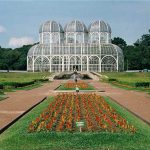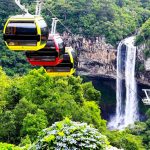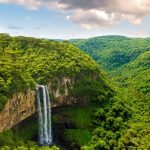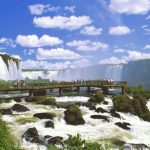The region’s major attraction, encompassing the states of Rio Grande Do Sul, Santa Catarina and Paraná, are the Iguassu Falls, the Jesuit Missions are other major highlights in the South Region, spreading from the inland of Rio Grande do Sul over Argentina and Paraguay. In the montains of three states were the areas where the German, Italian and other European families choose for this colonies in Brazil.
Perfect for: Families.
Best Time: During the summer to enjoy the beaches of Santa Catarina or Iguassu falls waterfalls are more copious.
Curitiba (Paraná): The capital of Paraná, Curitiba, is one of Brazil’s urban success stories, with parks, well preserved historic buildings, good urban system transportation.
Iguassu Falls (Paraná): Long before the Spanish explorer Don Alvar Nuñes reached South America’s greatest waterfall in 1541, the local indians had named it Iguassu – meaning great waters. There is no more fitting description, as thousands of visitors to Iguassú each year will testify. Once seen, the falls – all 275 of them – are never forgotten. The two-mile wide curtain of water crashing 300ft over a series of precipices into a spray-filled gorge constitutes the most spectacular sight of southern Brazil and probably the whole of South America. Even though this destination is sold as a day trip out of Rio, or even a one night stop, two or three days at least should ideally be spent in this fascinating area. This allows time to enjoy the falls from both the Brazilian and Argentinean sides, ride over them by helicopter and approach them on a jungle / river trek. An extended stay, too, gives time to visit Foz do Iguassu, the Brazilian border town nearby that mushroomed in the late 1980s when Itaipu, the world’s largest hydroelectric plant, was built (excursions operate to the dam); also to take in Puerto Iguazu in Argentina and Ciudad del Leste in Paraguay. But back to the falls, a trail winds towards the falls from the area in front of the Tropical Hotel das Cataratas, populated by contis, long-tailed racoon-like creatures with a well-developed sense of tourists’ feeding habits. At its end, an elevator provides speedier access to a viewing platform at the foot of the falls. Focal point of the falls, best seen from above, is the Devil’s Throat, a horseshoe-shaped gully in mid-stream over which seems to pour most of the Iguaçu River at the phenomenal rate of 13,000 cubic meters a second. To experience the deafening roar and feel the spray at really close quarters, a trip to the Argentinian side – by organized excursion – is a must. One walks for 20 minutes along catwalks past alligators dozing in the shallows, to stand hypnotized by the thundering waters that fill the air with spay and render conversation near impossible. Above, the helicopter swoops and turns, giving tourists a gallery view of nature’s design work on a spectacular seven-minute ride back and forth across the falls’ most stunning points. Longer flights take one to see Itaipu dam.
Florianopolis (Santa Catarina): It looks like the island was made for tourism. Its wide area (436,5sq.m.) includes dozens of beaches, large portions of preserved woods and two large salt water laggons (Conceição and Peri) as cospious as the sea.The trendiest beaches are Brava and Mole, appeal to a crownd of youths searching for good surf conditions and lots of partying. The best restaurants and bars are located in the surroundings of Lagoa da Conceição, but if you look for tranquility go directly to south side where you will find the translucent waters.
Mel Island (Paraná): The main destination at Iguassu coast is acessible through small boats leaving from Pontal do Sul, the nearest and most frequent point of departure, or from the larger Port of Paranaguá. If you like nature and little bit of adventure this destination is prefect.
Porto Alegre (Rio Grande do Sul): The capital of Rio Grande do Sul is a lively and modern city and offers big city attractions, like technology museuns and night time excitement at the bohemian district of Moinhos de Vento, while preserving the cultural heritage in such habits as the copious drinking of chimarrão, a local hot herbal beverage. The city is also known for proundly cherishing one of its major landmarks: the beautiful sunset at Guaíba river.






